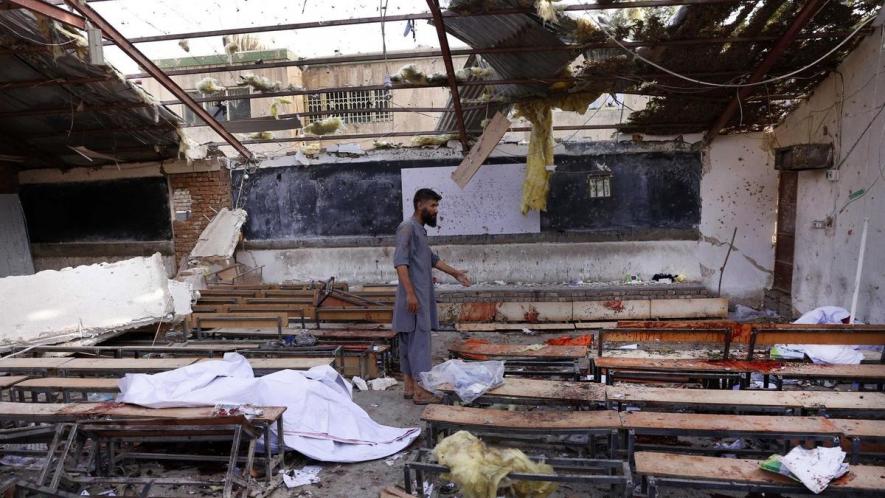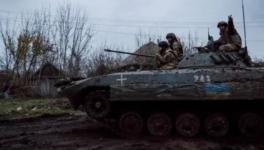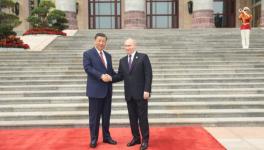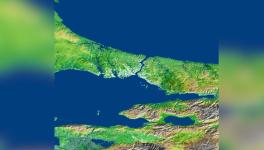When the Classroom is the Target

There is always something wonderful about seeing children on their way to school. An expectation that they will find something in what they are reading or in what they are talking about that sparks an interest, draws them to worlds that are different from their own, gives them a new kind of confidence and a fresh ambition. Even the most tiresome curriculum can be an eyeopener: a story that is unknown, a line in a book that allows the child to soar.
Whether this is a classroom up in Baalbek (Lebanon) or in Kabul’s Chaman-e-Babrak (Afghanistan), these children – refugees from Syria in one and from Afghanistan’s countryside in the other – find a little sanctuary in them. There are often tarpaulins from UNHCR – the UN refugee agency – holding the makeshift classroom together and, if the children are fortunate, there are backpacks for them from UNICEF – the UN children’s agency. The bombing of the school bus in Yemen last week left these backpacks strewn across the road in the busy market town of Dahyan.
On August 15, about five hundred young people – age 16 to 18 – filled the hall in the Mowud Education Centre in Kabul’s Dasht-i Barcha neighbourhood. They were in a college preparatory class, hoping that these extra, private tuitions would help them get ahead in their college entrance examinations. This Wednesday, the students were getting ready to do their work when a strange man entered the hall, detonated a suicide vest and killed 48 of the students (injuring close to a 100). Time and ambition ended not only for the students who died, but also for those who will suffer the scars of this atrocity for a long time hence.
Scattered around the broken hall are books to prepare for the physics examination, shoes, backpacks. There are always backpacks.
Anti-Shia Violence.
Dasht-i Barcha in western Kabul is no stranger to such violence. So much of it resembles so many of Kabul’s burgeoning slums, areas of the city taken up by people who have fled the countryside as war drifts across the Afghan landscape. It is the Hazara population from western Afghanistan who have settled in this area. A largely Shia neighbourhood, Dasht-i Barcha has been a frequent target for the frustrations of Afghanistan’s Taliban and now its Islamic State (ISIS).
In July 2016, thousands of protestors marched away from Dasht-i Barcha towards Deh Mazang Square – near the centre of town (and the Kabul Zoo). They had come to protest the creation of an electricity grid along their lands near the Salang Pass. Comprised mainly of the Hazara community, this Enlightenment Movement protest had come in a festival atmosphere. Two suicide bombers struck in the midst of the large crowd, killing at least 100 people and injuring almost 300. ISIS first claimed the attack, and then – when public opinion went to the side of the Hazaras – denied it. But it was clear that this was an attack on the Hazaras more than an attack on the anti-grid protestors.
Anti-Shia violence defines the world-view of ISIS, which seems more fixated on doctrinal difficulties with Shiism than with the NATO occupation of Afghanistan. Cruel acts of violence by ISIS in Afghanistan is mirrored by such violence in Iraq and Syria. The suicide bomber this week did not choose any school to target. He chose a school in a Hazara neighbourhood, a private tutoring class that draws mainly Hazara youth. Five months ago, a man threw a grenade at a nearby private school. Such acts of violence against school children in this neighbourhood is no longer uncommon. This is the third major attack on a school in this neighbourhood.
Anti-Shia violence has drawn the Hazara – typically a heterodox community – closer and closer to Iranian orthodoxy. Dasht-i Barcha, like Lebanon’s Nabatieh, increasingly mimics Iranian fashions for both men and women. Connections with Iran were always there, but now the feeling that Iran will protect the Hazara against the tide of anti-Shia violence has increased. It has had cultural ramifications that are deeper than political alliances. It is almost as if ISIS seeks to break whatever remains of Afghan nationalism and create the conditions for a truly sectarian war. It is not the situation now, but the temptations to go in that direction exist. Already one hears talk amongst Hazara leaders of self-defence, particularly as confidence in the Afghan security services weakens.
Blind like me.
Raha, a university student, writes for the Afghan Women’s Writing Project. She visits some friends in Dasht-i Barcha. On her way home, she passes a man on the narrow streets. She asks him if he sends his daughters to school. ‘Dear daughter’, he says to her, ‘I send them because I don’t want them to be blind like me. People with no education are blind. I want them to improve their lives. Our times is passed now. I want to let them enjoy the new world’. Raha recounted these words in March 2016, before the bombings in July of that year and of course before this week’s bombings. The man’s response pleased her. She was taken by his hope.
Get the latest reports & analysis with people's perspective on Protests, movements & deep analytical videos, discussions of the current affairs in your Telegram app. Subscribe to NewsClick's Telegram channel & get Real-Time updates on stories, as they get published on our website.
























